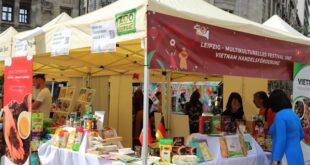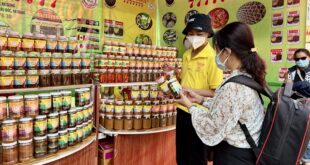 |
| Tens of thousands people attend the concert ‘Born Pink’ by South Korean girl supergroup BlackPink in Hà Nội. Their two concerts in Hà Nội on July 29-30, 2023 are part of their Born Pink World Tour. VNA/VNS Photo |
HÀ NỘI – Cultural industries, still having much room to develop and contribute more to the national economy, are being considered an important resource to be maximised to boost the GDP growth.
In a resolution on the outcomes of the Government’s June meeting and its teleconference with localities on July 10, the Government called on ministries, sectors, localities, businesses, and the entire society to further strive in the remaining months of this year to achieve the yearly GDP growth rate of 6.5-7 per cent and to maintain development momentum for 2025.
In challenging objective and subjective conditions, promoting GDP growth is not easy, so all available resources must be brought into full play, the Government stressed.
It defines cultural industries as encompassing 12 sectors: advertising; architecture; software and entertainment games; handicrafts; design; cinema; publishing; fashion; performing arts; fine arts, photography, and exhibition; television and radio broadcasting; and cultural tourism.
The National Target Programme for Cultural Development for the 2025-2035 period aims to develop culture into an intrinsic strength of the economy. By 2035, the cultural industries are expected to contribute 8 per cent to the national GDP.
According to the Ministry of Culture, Sports and Tourism, the production value of Việt Nam’s cultural industries in the 2018 – 2022 period neared VNĐ1.1 quadrillion (US$43.4 billion). Their added value to the economy reached 6.02 per cent in 2019. However, the figure decreased to 4.32 per cent and 3.92 per cent in 2020 and 2021 due to the impact of the COVID-19 pandemic. In 2022 and 2023, they began to recover, contributing more than 4 per cent to the country’s GDP annually.
Over the recent years, the cultural industries in the country have gained certain achievements, with their products increasingly diverse, many of which have high values, creating a reputation domestically and internationally.
The country has also seen increases in the numbers of businesses and workers involved in the cultural industries. In the 2018-2022 period, the number of economic establishments operating in these industries increased by 7.2 per cent annually, while the workforce grew by 7.4 per cent annually, attracting approximately 2.3 million workers, accounting for 4.42 per cent of the total labour force.
Currently, six out of the 12 cultural industry sectors are experiencing significant growth.
The film industry, in particular, is showing rapid development with an average annual production value increase of 8.03 per cent. Young people constitute 80 per cent of the cinema audience, indicating substantial potential for the sector to grow further. In 2023, the total revenue from the more than 25 Vietnamese films released reached VNĐ1.56 trillion, marking the first year when domestic films held over 42 per cent of the market share in Việt Nam’s film industry.
 |
| American celebrity singer Katy Perry performs in Hồ Gươm Theatre in Hà Nội on December 20, 2023. Photo dantri.com.vn |
Last year, revenue from cultural tourism was nearly VNĐ38 trillion out of the total tourism revenue of VNĐ672 trillion.
In the performing arts sector, creative, arts, and entertainment activities in the 2018-2022 period saw an average production value increase of 5.59 per cent. There are currently 130 theatres and professional art troupes nationwide.
Meanwhile, the fine arts, photography, and exhibition sector has experienced an average production value increase of 6.5 per cent.
In 2022, advertising revenue approximated US$2.19 billion. The growth rate of the domestic advertising market was 12.7 per cent, ranking fifth among the ASEAN countries.
Resources for developing cultural industries are diverse and rich, as Việt Nam has both material resources such as natural landscapes, historical landmarks, festivals, and traditional handicrafts; and non-material ones such as cultural identity of the Vietnamese people, their creativity and characters, and intangible cultural heritage. VNA/VNS
- Reduce Hair Loss with PURA D’OR Gold Label Shampoo
- Castor Oil Has Made a “Huge” Difference With Hair and Brow Growth
- Excessive hair loss in men: Signs of illness that cannot be subjective
- Dịch Vụ SEO Website ở Los Angeles, CA: đưa trang web doanh nghiệp bạn lên top Google
- Nails Salon Sierra Madre
 VnExpress News The News Gateway of Vietnam
VnExpress News The News Gateway of Vietnam





